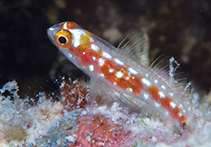| Family: |
Gobiidae (Gobies), subfamily: Gobiinae |
| Max. size: |
1.64 cm SL (male/unsexed) |
| Environment: |
reef-associated; marine; depth range 1 - 30 m |
| Distribution: |
Southwestern Pacific: Fiji and Tonga. |
| Diagnosis: |
Dorsal spines (total): 7-7; Dorsal soft rays (total): 9-9; Anal spines: 1-1; Anal soft rays: 8-8. This species is distinguished from its congeners by the following characters: a cephalic sensory-canal pore pattern lacking only IT pore (pattern 2), AITO pore small and opening dorsally; a dorsal/anal fin-ray formula of 9/8; unbranched pectoral-fin rays 16 or 17 (usually 17); fifth pelvic-fin ray 5-17% of fourth ray; body depth 18-23% SL. Colouration: pectoral-fin base without dark occipital spots or dark spots; entire iris of eye is dark reddish, pupil surrounded by a white ring, dorsal side of eye next to interorbital area has a short white bar not visible laterally; a two-part, black, basicaudal spot over preural centrum made up of a short, wedge-like, triangular front section connecting to a short, wide bar over end of hypural plate, and with a yellow spot over nexus; caudal fin is crossed by thin, red, diagonal bars, pale when preserved (Ref. 127576). |
| Biology: |
Collected from consolidated coral growth rising 2 m off sand and silt bottom, in 9-15 m depth; also from turbid waters on fine-sand and coral-rubble bottom (Ref. 127576). |
| IUCN Red List Status: |
Least Concern (LC); Date assessed: 06 March 2015 Ref. (130435)
|
| Threat to humans: |
harmless |
Source and more info: www.fishbase.org. For personal, classroom, and other internal use only. Not for publication.
